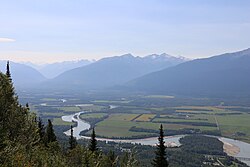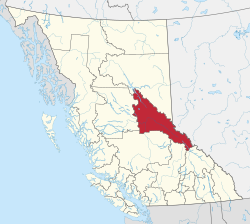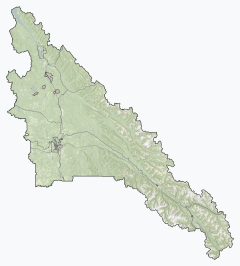Regional District of Fraser–Fort George
Fraser–Fort George | |
|---|---|
| Regional District of Fraser–Fort George | |
 Upper Fraser River | |
Major communities | |
 Location in British Columbia | |
| Country | Canada |
| Province | British Columbia |
| Administrative office location | Prince George |
| Government | |
| • Type | Regional district |
| • Body | Board of directors |
| • Chair | Art Kaehn (E) |
| • Vice chair | Lara Beckett (C) |
| • Electoral areas |
|
| Area | |
| • Land | 50,676.10 km2 (19,566.15 sq mi) |
| Population (2016)[2] | |
| • Total | 94,506 |
| • Density | 1.86/km2 (4.8/sq mi) |
| Website | www |
The Regional District of Fraser–Fort George (RDFFG) is a regional district located in the Central Interior of British Columbia, Canada. It is bounded by the Alberta border to the east, the Columbia–Shuswap and Thompson–Nicola regional districts to the south and southeast, Cariboo Regional District to the southwest, the Regional District of Bulkley–Nechako to the west, and the Peace River Regional District to the north and northeast. As of the Canada 2011 Census, Fraser–Fort George had a population of 91,879 and a land area of 51,083.73 km2 (19,723.54 sq mi). The offices of the regional district are located at Prince George.
Communities
[edit]City
[edit]District municipality
[edit]Villages
[edit]Regional district electoral areas
[edit]- Fraser–Fort George A – Salmon River–Lakes
- Fraser–Fort George C – Chilako River–Nechako
- Fraser–Fort George D – Tabor Lake–Stone Creek
- Fraser–Fort George E – Woodpecker–Hixon
- Fraser–Fort George F – Willow River–Upper Fraser
- Fraser–Fort George G – Crooked River–Parsnip
- Fraser–Fort George H – Robson Valley–Canoe
Indian Reserves
[edit]NB Indian Reserves are not part of municipal or regional district governance and are outside the regional district's jurisdiction, and also counted separately in the census figures.
- Fort George (Shelley) Indian Reserve No. 2
- McLeod Lake Indian Reserve No. 1
- Parsnip Indian Reserve No. 5
Designated places
[edit]Demographics
[edit]As a census division in the 2021 Census of Population conducted by Statistics Canada, the Regional District of Fraser-Fort George had a population of 96,979 living in 40,224 of its 43,377 total private dwellings, a change of 2.6% from its 2016 population of 94,506. With a land area of 50,580.72 km2 (19,529.33 sq mi), it had a population density of 1.9/km2 (5.0/sq mi) in 2021.[3]
| Panethnic group |
2021[4] | 2016[5] | 2011[6] | 2006[7] | 2001[8] | 1996[9] | 1991[10][11] | |||||||
|---|---|---|---|---|---|---|---|---|---|---|---|---|---|---|
| Pop. | % | Pop. | % | Pop. | % | Pop. | % | Pop. | % | Pop. | % | Pop. | % | |
| European[a] | 71,800 | 75.34% | 72,560 | 78.08% | 73,895 | 81.66% | 77,320 | 84.39% | 80,945 | 85.34% | 87,785 | 89.12% | 78,765 | 87.15% |
| Indigenous | 13,995 | 14.69% | 13,395 | 14.41% | 10,915 | 12.06% | 9,630 | 10.51% | 8,875 | 9.36% | 6,355 | 6.45% | 7,970 | 8.82% |
| South Asian | 4,060 | 4.26% | 2,640 | 2.84% | 2,020 | 2.23% | 2,040 | 2.23% | 2,620 | 2.76% | 2,035 | 2.07% | 1,930 | 2.14% |
| Southeast Asian[b] | 1,850 | 1.94% | 1,460 | 1.57% | 1,250 | 1.38% | 780 | 0.85% | 615 | 0.65% | 355 | 0.36% | 365 | 0.4% |
| East Asian[c] | 1,565 | 1.64% | 1,390 | 1.5% | 1,345 | 1.49% | 1,130 | 1.23% | 1,095 | 1.15% | 1,290 | 1.31% | 810 | 0.9% |
| African | 1,170 | 1.23% | 755 | 0.81% | 615 | 0.68% | 400 | 0.44% | 380 | 0.4% | 360 | 0.37% | 380 | 0.42% |
| Latin American | 265 | 0.28% | 275 | 0.3% | 155 | 0.17% | 140 | 0.15% | 205 | 0.22% | 95 | 0.1% | 130 | 0.14% |
| Middle Eastern[d] | 250 | 0.26% | 215 | 0.23% | 205 | 0.23% | 65 | 0.07% | 0 | 0% | 50 | 0.05% | 30 | 0.03% |
| Other[e] | 335 | 0.35% | 240 | 0.26% | 105 | 0.12% | 130 | 0.14% | 130 | 0.14% | 170 | 0.17% | — | — |
| Total responses | 95,300 | 98.27% | 92,935 | 98.34% | 90,495 | 98.49% | 91,625 | 99.31% | 94,855 | 99.52% | 98,505 | 99.53% | 90,380 | 99.6% |
| Total population | 96,979 | 100% | 94,506 | 100% | 91,879 | 100% | 92,264 | 100% | 95,317 | 100% | 98,974 | 100% | 90,739 | 100% |
- Note: Totals greater than 100% due to multiple origin responses.
Notes
[edit]- ^ Statistic includes all persons that did not make up part of a visible minority or an indigenous identity.
- ^ Statistic includes total responses of "Filipino" and "Southeast Asian" under visible minority section on census.
- ^ Statistic includes total responses of "Chinese", "Korean", and "Japanese" under visible minority section on census.
- ^ Statistic includes total responses of "West Asian" and "Arab" under visible minority section on census.
- ^ Statistic includes total responses of "Visible minority, n.i.e." and "Multiple visible minorities" under visible minority section on census.
References
[edit]- ^ "Board of Directors". Retrieved July 9, 2019.
- ^ a b "Population and dwelling counts, for Canada, provinces and territories, and census divisions, 2016 and 2011 censuses – 100% data (British Columbia)". Statistics Canada. February 8, 2017. Retrieved July 9, 2019.
- ^ "Population and dwelling counts: Canada and census divisions". Statistics Canada. February 9, 2022. Retrieved April 3, 2022.
- ^ Government of Canada, Statistics Canada (October 26, 2022). "Census Profile, 2021 Census of Population". www12.statcan.gc.ca. Retrieved February 17, 2023.
- ^ Government of Canada, Statistics Canada (October 27, 2021). "Census Profile, 2016 Census". www12.statcan.gc.ca. Retrieved February 17, 2023.
- ^ Government of Canada, Statistics Canada (November 27, 2015). "NHS Profile". www12.statcan.gc.ca. Retrieved February 17, 2023.
- ^ Government of Canada, Statistics Canada (August 20, 2019). "2006 Community Profiles". www12.statcan.gc.ca. Retrieved February 17, 2023.
- ^ Government of Canada, Statistics Canada (July 2, 2019). "2001 Community Profiles". www12.statcan.gc.ca. Retrieved February 17, 2023.
- ^ Government of Canada, Statistics Canada (June 4, 2019). "Electronic Area Profiles Profile of Census Divisions and Subdivisions, 1996 Census". www12.statcan.gc.ca. Retrieved February 17, 2023.
- ^ Government of Canada, Statistics Canada (March 29, 2019). "1991 Census Area Profiles Profile of Census Divisions and Subdivisions – Part B". www12.statcan.gc.ca. Retrieved February 18, 2023.
- ^ Government of Canada, Statistics Canada (March 29, 2019). "Data tables, 1991 Census Population by Ethnic Origin (24), Showing Single and Multiple Origins (2) – Canada, provinces and territories, census divisions and census subdivisions". www12.statcan.gc.ca. Retrieved February 18, 2023.
External links
[edit]


